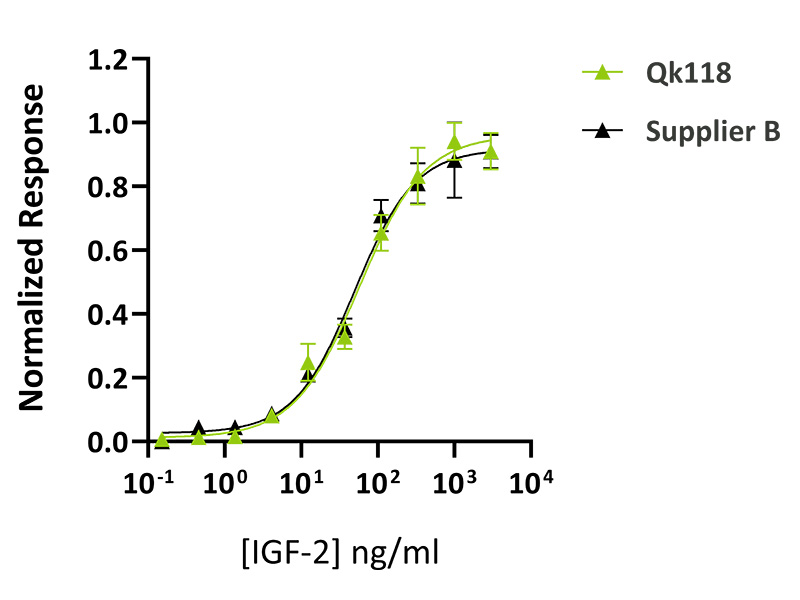 Recombinant human IGF-2 protein (Qk118)
Recombinant human IGF-2 protein (Qk118)Recombinant human IGF-2 protein (Qk118)
£140.00 – £800.00

Insulin-like Growth Factor 2 (IGF-2) is a growth factor that promotes cell proliferation, differentiation, and survival, particularly during fetal development. IGF-2 also regulates tissue growth and muscle regeneration.
Qkine human IGF-2 is a highly pure 7.5 kDa monomer, animal origin-free (AOF) and carrier-protein-free (CF). Qkine has optimised the IGF-2 manufacture process to produce a highly bioactive protein with excellent lot-to-lot consistency for enhanced experimental reproducibility.
In stock
Orders are typically shipped same or next day (except Friday).
Easy world-wide ordering, direct or through our distributors.
£140.00 – £800.00
Fast and free shipping.
Buy online with secure credit card or purchase order. For any questions, please email orders@qkine.com
Summary:
- High purity human IGF-2 protein (Uniprot: P01344)
- 7.5 kDa
>98%, by SDS-PAGE quantitative densitometry
Expressed in E. coli
Animal origin-free (AOF) and carrier protein-free
Manufactured in our Cambridge, UK laboratories
Lyophilized from acetonitrile, TFA
- Resuspend in sterile-filtered water at >50 µg/ml, add carrier protein if desired, prepare single use aliquots and store frozen at -20 °C (short-term) or -80 °C (long-term).
Featured applications:
Cellular proliferation, migration and survival
iPSC and primary cell differentiation to muscle
Osteogenic differentiation

Recombinant IGF-2 activity was determined using an SRE reporter assay on transfected MCF-7 cells. Cells were treated in triplicate with a serial dilution of IGF-2 for 4 hours. Firefly activity was measured and normalized to the control Renilla luciferase activity. Data from Qk118 lot 204687. EC50 = 58 ng/ml (7.8 nM)
Recombinant IGF-2 migrates at approximately 7.5 kDa in reduced (R) and non-reduced (NR) conditions. No contaminating protein bands are present. The purified recombinant protein (3 µg) was resolved using 18% w/v SDS-PAGE in reduced (+β-mercaptoethanol, R) and non-reduced (NR) conditions and stained with Coomassie Brilliant Blue R250. Data from Qk118 lot #204687.

Further quality assays
Mass spectrometry: single species with expected mass
Recovery from stock vial: >95%
Endotoxin: <0.005 EU/μg protein (below level of detection)
We are a company founded and run by scientists to provide a service and support innovation in stem cell biology and regenerative medicine. All our products are exceptionally high purity, with complete characterisation and bioactivity analysis on every lot.

Qkine IGF-2 is as biologically active as the comparable alternative supplier protein. IGF-2 activity was determined using the serum response element (SRE) firefly luciferase reporter assay in transfected MCF-7 cells. Cells were treated in triplicate with a serial dilution of IGF-2 (Qk118, green) or alternative supplier IGF-2 (supplier B, black). Firefly luciferase activity was measured and normalized to the control Renilla luciferase activity. Data from Qk118 lot #204687.
Technote | IGF-2 (Qk118) bioactivityProtein background
IGF-2, or Insulin-like Growth Factor 2, is a protein hormone that plays a crucial role in growth and development, particularly during fetal development. It is part of the insulin-like growth factor family, which includes IGF-1 and insulin. IGF-2 is a single-chain polypeptide consisting of 67 amino acids, with a molecular weight of 7.5 kDa. The protein’s three-dimensional structure is characterized by three alpha-helices stabilized by three disulfide bonds [1]. These disulfide bonds are formed between six conserved cysteine residues, which are critical for maintaining the protein’s tertiary structure and biological activity. The overall fold of IGF-2 is similar to that of insulin, reflecting their evolutionary relationship [2].
IGF-2 has numerous applications across various fields. In prenatal development, it is crucial for fetal growth and development, influencing organ size and body composition. It’s used as a marker in prenatal diagnostics to assess fetal growth and potential developmental issues [3]. In cancer research, IGF-2 has been implicated in various cancers, including colorectal, breast, and prostate cancer. It’s being studied as a potential biomarker for early cancer detection and as a target for cancer therapies. Given its role in glucose metabolism, IGF-2 is also being investigated in the context of metabolic disorders such as diabetes and obesity, with researchers exploring its potential in developing new treatments [4].
IGF-2 has tissue engineering and regenerative medicine applications, particularly in wound healing and tissue repair. IGF-2 has neuroprotective effects, suggesting potential applications in treating neurodegenerative disorders like Alzheimer’s disease. IGF-2 gene polymorphisms are used as genetic markers for selective breeding to improve meat quality and production efficiency [5]. Additionally, as a growth factor, IGF-2 is monitored in sports medicine to detect potential abuse for performance enhancement. The ongoing research into IGF-2’s structure and functions continues to open new avenues for applications in medicine, biotechnology, and agriculture, underlining its significance across multiple disciplines [6].
Additional resources
Our products are for research use only and not for diagnostic or therapeutic use. Products are not for resale.

Receive an Amazon gift voucher when you leave us a review.
£25, $30 or €30 for reviews with an image and £10, $15 or €15 for reviews without an image